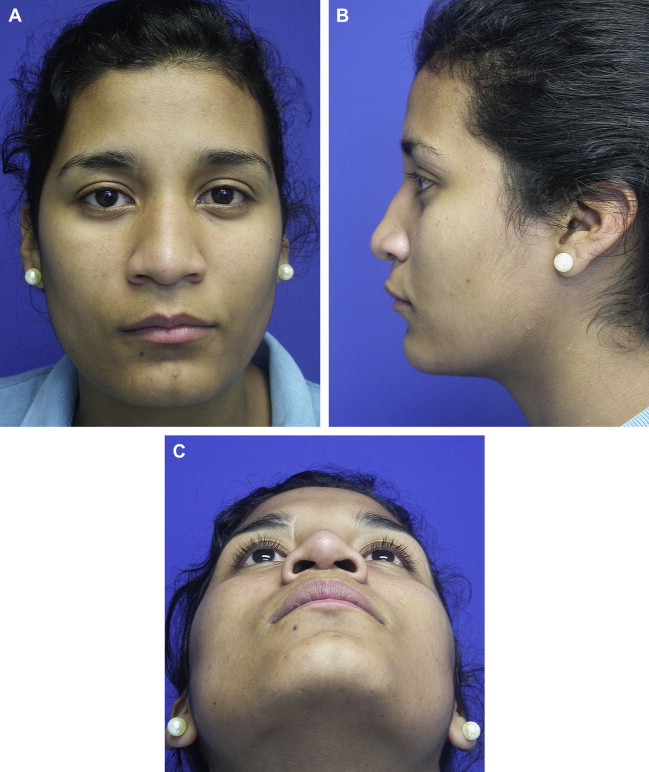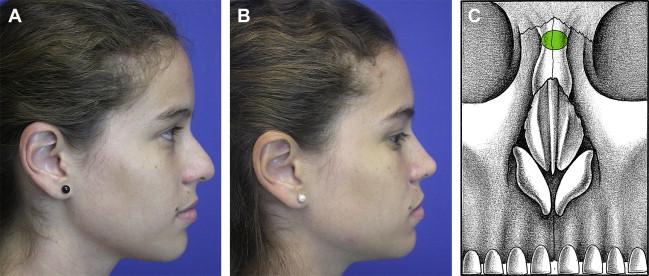Rhinoplasty is one of the most common facial plastic procedures performed in the Hispanic/mestizo ethnic group. Today, emphasis is placed on ethnic and cultural backgrounds, definition of facial and nasal characteristics, and a clear understanding of patients’ desires. This article highlights the different types of problems encountered in mestizo patients. It describes a graduated approach to the nose whereby support structures of the nose are strengthened by careful placement of sutures and grafts, trying to achieve greater definition and support without necessarily making the nose look bigger.
There are many different ethnic groups in the world. Wars and the search for better working opportunities have changed migration patterns around the world. Rich developed countries are constantly receiving immigrants from poor countries who seek opportunities for a better quality of life for themselves and their families. This has changed the racial composition of many countries and pure races are being replaced by more mixed multiracial groups.
The United States, Spain, and, in a lesser proportion, Canada and the European countries have had big migrations from Latin American countries. The largest minority ethnic group in the United States is the mestizos or Hispanics.
Cosmetic rhinoplasty has grown in demand over the years and today, with the exception of minimally invasive cosmetic procedures, it is the most frequently performed facial plastic surgery around the world. Through the ages, the ideal facial characteristics have been defined following the characteristics of whites whereby the ideal nose is defined as moderately thin, with a strong bony dorsum, and a tip that is angular and slightly projecting. Each ethnic group has its own defined beauty patterns that are influenced by cultural backgrounds and religious upbringing, but globalization and communication media have popularized the white or western look worldwide.
Today, facial plastic surgeons are faced with patients who come from many different ethnic groups, and they find that what had been established as a standard of beauty when performing rhinoplasty does not necessarily give these patients what they want. Mestizo patients are not the exception and, for surgeons, it has become a priority to define exactly what the patient wants and whether the surgical result is attainable.
Mestizo race
The term Hispanic is defined as coming from a Spanish-speaking country (Larousse American Pocket English Dictionary). Most Latin American countries are Spanish-speaking countries, and patients who come from these countries are commonly referred to as Hispanic, Latino or mestizo.
Mestizo is a definition that takes into account racial characteristics. It literally means a mixture of races. The history of Latin American mestizos started more than 30,000 years ago when people with Asian and Mongolian features crossed the Bering Strait and formed the different Indian tribes that inhabited the region when the Spanish discovered America in the fifteenth and sixteenth centuries. Africans were brought over as slaves during the eighteenth century. For this reason mestizo is defined as a mixture of 3 predominant races: Indian, white, and negroid.
In Latin America, mestizos do not have a specific racial pattern, and the predominant features vary depending on the geographic zone from which the patient originates. People from Mexico, Peru, Bolivia, and many of the Central American countries exhibit stronger Indian facial characteristics, whereas in Argentina and Chile there is a strong influence from the different European countries. Furthermore, in countries such as Brazil, the Caribbean islands, and the coasts of Colombia and Venezuela, there is a stronger African influence. Today, the mestizo race is characterized by diversity and mixtures; and one cannot find a single element, culture, or racial feature predominating over the rest in a persistent pattern.
In the United States the Hispanic or Latin population comes mainly from Mexico, Central American countries, Colombia, Venezuela, Ecuador, and Peru. This population is concentrated in the southwestern border area (California, Texas, Arizona, New Mexico), Florida, and New York City, some of which are the main ports of entry into the country. Once established, the mestizo population has blended with the surrounding environment, and they can be found in all states of the nation.
Mestizo nasal characteristics
Mestizo nasal characteristics differ from the accepted ideal white or western nose. The faces of these patients tend to be broad with a nose that looks small, undefined, and slightly flattened. The skin in these patients is thicker, resulting in a heavier skin–soft tissue envelope (S-STE).
The underlying structural support of these noses tends to be poor and unsupportive: bones are small and wide, cartilaginous structures tend to be flimsy and weak. Nasal bones tend to be small, although it is common to find patients with a deep radix and a small hump. Cartilaginous vaults can be weak. Tip support mechanisms are usually poor because of a weak caudal septum, small nasal spine, and flimsy unsupportive alar cartilages.
Externally, these noses can have a wide nasal bridge, low radix, wide nasal base, short columella, acute nasolabial angle, and nostrils that tend to have a more flaring and horizontal shape. The external appearance of these noses is the reflection of a poor underlying architectural framework and a thick and heavy S-STE ( Table 1 ) ( Fig. 1 ).
| Characteristics | Mestizo | Caucasian |
|---|---|---|
| Skin type | Normal to thick/sebaceous | Normal to thin |
| S-STE | Thick | Thin |
| Nasal dorsum | Normal to low radix Wide nasal bridge | Normal radix Normal nasal bridge |
| Nasal bones | Short | Long |
| Middle third of nose/cartilaginous nasal vault | Weak, wide | Strong, normal trapezoid shape to narrow |
| Lower third of nose/nasal tip | Flimsy/unsupportive | Strong |
| Alar cartilages | Wide, flimsy, undefined | Normal width, strong, defined |
| Columella | Normal to short | Normal to long |
| Nasolabial angle | Normal to acute | Normal to obtuse |
| Nasal spine | Normal to short | Normal to long |
| Tip recoil | Poor | Strong |
| Nostril shape | Horizontal shape | Oval shape |
| Alar base | Normal to wide | Normal to narrow |

Mestizo nasal characteristics
Mestizo nasal characteristics differ from the accepted ideal white or western nose. The faces of these patients tend to be broad with a nose that looks small, undefined, and slightly flattened. The skin in these patients is thicker, resulting in a heavier skin–soft tissue envelope (S-STE).
The underlying structural support of these noses tends to be poor and unsupportive: bones are small and wide, cartilaginous structures tend to be flimsy and weak. Nasal bones tend to be small, although it is common to find patients with a deep radix and a small hump. Cartilaginous vaults can be weak. Tip support mechanisms are usually poor because of a weak caudal septum, small nasal spine, and flimsy unsupportive alar cartilages.
Externally, these noses can have a wide nasal bridge, low radix, wide nasal base, short columella, acute nasolabial angle, and nostrils that tend to have a more flaring and horizontal shape. The external appearance of these noses is the reflection of a poor underlying architectural framework and a thick and heavy S-STE ( Table 1 ) ( Fig. 1 ).
| Characteristics | Mestizo | Caucasian |
|---|---|---|
| Skin type | Normal to thick/sebaceous | Normal to thin |
| S-STE | Thick | Thin |
| Nasal dorsum | Normal to low radix Wide nasal bridge | Normal radix Normal nasal bridge |
| Nasal bones | Short | Long |
| Middle third of nose/cartilaginous nasal vault | Weak, wide | Strong, normal trapezoid shape to narrow |
| Lower third of nose/nasal tip | Flimsy/unsupportive | Strong |
| Alar cartilages | Wide, flimsy, undefined | Normal width, strong, defined |
| Columella | Normal to short | Normal to long |
| Nasolabial angle | Normal to acute | Normal to obtuse |
| Nasal spine | Normal to short | Normal to long |
| Tip recoil | Poor | Strong |
| Nostril shape | Horizontal shape | Oval shape |
| Alar base | Normal to wide | Normal to narrow |
Preoperative evaluation
During the preoperative consultation, additional to the standard consultation and physical examination, several questions must be answered with the help of the patient.
- 1.
Is it possible to establish a predominant racial feature?
- a.
What nasal characteristics are present in the patient?
- a.
- 2.
What is the patient’s ethnic and racial background?
- a.
Does he or she want to preserve these features
- a.
- 3.
Is there a clear understanding between surgeon and patient of desires and expectations?
- 4.
Has a realistic surgical plan been outlined and shown to the patient?
- 5.
Have possible limitations, complications, and undesirable results been discussed with the patient?
Step-wise approach to the mestizo nose
It is common to find anatomic variations within the mestizo population that depend on the different racial features that are found: white, Indian, and African. The mestizo ethnic group comprises an enormous geographic territory and the different migration patterns and political circumstances that have occurred through time make it difficult to categorize these patients into a specific racial group. Once an accurate anatomic diagnosis is made, problems can be defined and categorized and surgical approaches and techniques can be elaborated ( Box 1 ).
Anatomic diagnosis
Definition of existing problem
Definition of surgical approaches and techniques
This step-wise approach can be organized if the surgeon has a clear understanding of what the patient wants. Mestizo patients usually want a nose that looks smaller and more defined. Surgically, this translates into techniques that provide structural support but without making the nose look much bigger.
Anatomically, what is frequently encountered in these patients is as follows:
- •
Thick S-STE
- •
Weak bony and cartilaginous support structures of the nose.
Surgical techniques in the mestizo patient
Mestizo rhinoplasty is a real challenge because there are no standard surgical techniques that can be applied in all cases. The problems encountered in each patient must be individually and carefully defined and the surgical solutions applied. All cases are performed under general anesthesia and the external approach is used in most patients. Surgical techniques are defined using a structural approach in these patients: conservative tissue excision, preservation of support structures of the nose, and structural grafting to increase strength and define anatomic structures.
One of the big problems encountered when this philosophic approach is used is that large amounts of cartilage are usually needed for structural grafting. In mestizo patients, the amount of quadrangular septal cartilage is not plentiful and is usually not thick. Techniques must be chosen wisely, and it is important to define the use of this limited cartilage: to augment, to strengthen, to fill in, and to smooth out regions of the nose ( Table 2 ).
| Anatomic Region | Procedure Performed |
|---|---|
| Upper third of nose |
|
| Middle third of nose |
|
| Lower third of nose |
|
Upper third of the nose
The bony dorsum in mestizo patients tends to be low and wide and can frequently have a small dorsal convexity.
The following problems are encountered in the upper third of the nose:
- 1.
Wide dorsum without hump
- 2.
Low radix with small dorsal convexity
- 3.
Low nasal dorsum.
Surgical Solutions
- 1.
Medial and lateral osteotomies: will help narrow a wide bony dorsum
- 2.
Radix graft: in those cases in which there is a low shallow radix with a small dorsal convexity, a morcelized radix graft can be used to fill in this space and avoid lowering the convexity of the dorsum. This technique helps build up the dorsum without making the nose look much bigger, and is an excellent alternative to the use of implants on the nasal dorsum ( Fig. 2 ).










